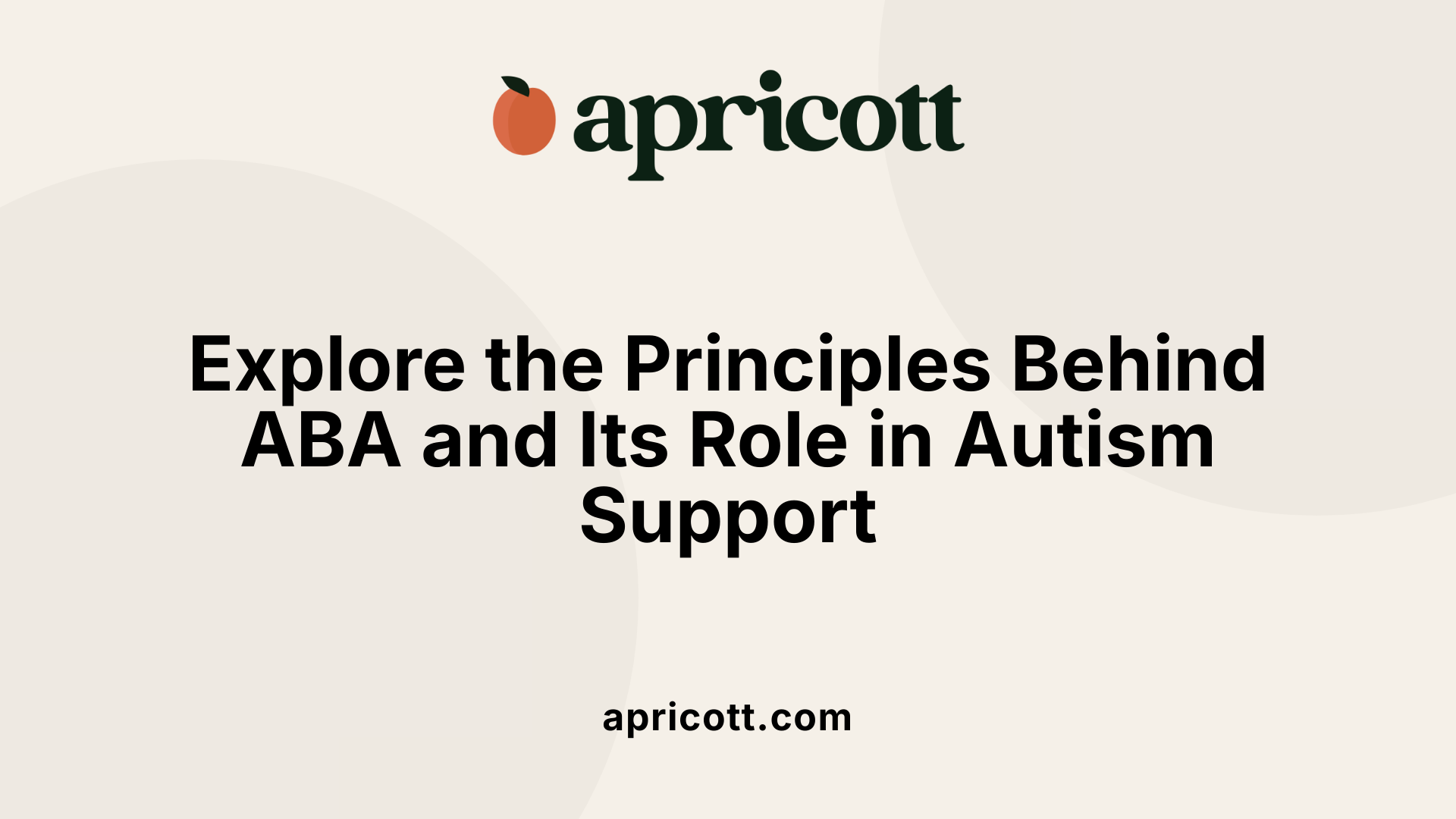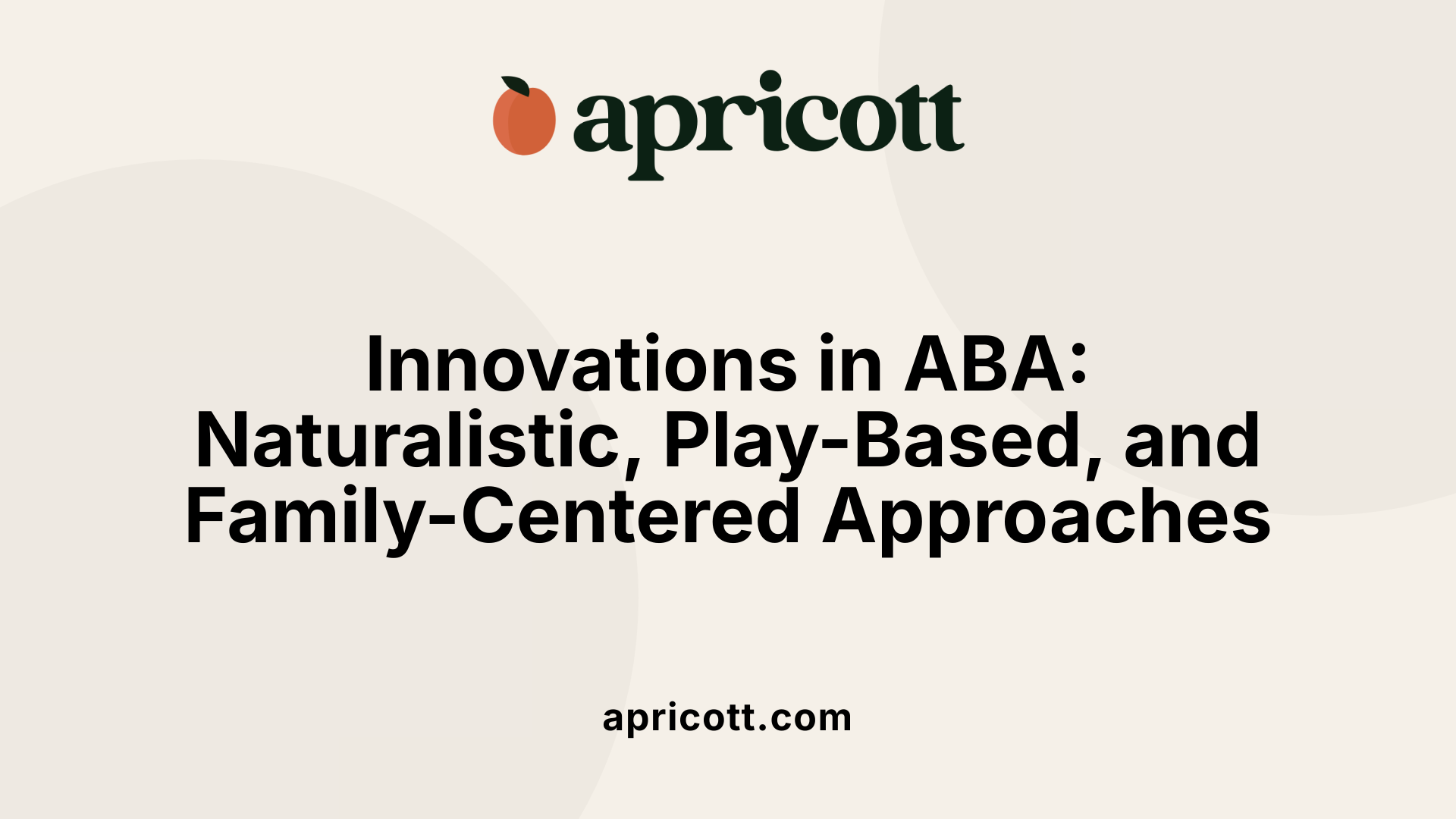Introduction to Autism's Historical Landscape
Autism spectrum disorder (ASD) has undergone significant conceptual and therapeutic evolution since it was first identified over a century ago. This overview sketches the historical milestones defining autism's recognition, diagnosis, and treatment advances, highlighting how behavioral science, particularly Applied Behavior Analysis (ABA), has shaped contemporary intervention strategies.
Early Recognition and Definitions of Autism

What is the origin of the term autism?
The term "autism" was first introduced in 1911 by Swiss psychiatrist Paul Eugen Bleuler. Originally, it was used to describe a subset of schizophrenic symptoms involving social withdrawal. However, the concept evolved significantly over the decades to refer to a distinct developmental condition.
Which early studies described autism traits?
In 1943, Leo Kanner published a seminal paper describing 11 children who exhibited unique behavioral patterns such as a profound focus on or obsession with objects. He coined the condition "infantile autism," marking one of the first clinical recognitions of autism as a separate disorder. Shortly after, in 1944, Hans Asperger described four children who shared similar autistic traits but with distinct differences, leading to the identification of Asperger's syndrome.
What were the distinct classifications of autism in the mid-20th century?
By the mid-20th century, autism was broadly separated into categories based on symptom severity and characteristics. Kanner's "infantile autism" was recognized as more severe, whereas Asperger's syndrome described children with autistic traits who had preserved language and intellectual abilities. These discrete classifications laid the foundation for understanding autism as a spectrum disorder, a concept further developed by Lorna Wing in the 1970s, who introduced the idea of a "triad of impairment" affecting social interaction, communication, and imagination.
Pioneering Work: Leo Kanner and Hans Asperger

Kanner's 1943 Description of 'Infantile Autism'
In 1943, psychiatrist Leo Kanner published a seminal paper describing 11 children who exhibited unique behaviors, particularly a profound focus on or obsession with objects. He coined this condition 'infantile autism,' marking one of the earliest formal recognitions of autism. Kanner's work highlighted distinctive patterns in social interaction and communication, providing a foundation for understanding autism as a distinct disorder.
Asperger's 1944 Study of Autistic Traits
One year later, in 1944, Hans Asperger presented his findings on four children exhibiting traits now associated with the autism spectrum. Unlike Kanner’s cases, Asperger’s children had relatively preserved language and cognitive skills but struggled with social interactions and displayed repetitive behaviors. His study eventually led to the identification of Asperger's syndrome as part of the broader spectrum.
Framing Subsequent Autism Spectrum Concepts
Kanner and Asperger’s early work laid critical groundwork for the concept of autism as a spectrum. While their initial descriptions differed in language and cognitive abilities, both emphasized challenges in social communication and repetitive behaviors. These observations were pivotal in the development of later diagnostic frameworks, such as the DSM-5, which unified autism-related conditions into autism spectrum disorder (ASD), reflecting a more comprehensive understanding of autism’s varied presentations.
Challenging Early Misconceptions About Autism

What was Bernard Rimland's role in changing perceptions of autism?
In 1964, Bernard Rimland played a pivotal role in transforming how autism was understood by challenging the "refrigerator mother" theory. This theory wrongly blamed cold and unaffectionate parenting for causing autism in children. Rimland's research emphasized neurological factors instead, highlighting autism as a developmental disorder with biological roots rather than a result of parenting styles.
How did this shift affect the understanding and treatment of autism?
Rimland's rejection of psychological blame shifted the scientific community's focus towards neurological explanations. This important change paved the way for biological research into autism's causes and fostered development of interventions that addressed the behavioral and neurological aspects of autism rather than parental behavior.
What influence did Rimland's perspective have on autism research and treatment approaches?
His advocacy for a neurological basis influenced the rise of evidence-based therapies, such as Applied Behavior Analysis (ABA), which focuses on observed behaviors and systematic reinforcement. By steering the field away from judgment and toward science-driven treatment, Rimland's work helped develop therapies that aim to improve communication, social skills, and independence for individuals on the autism spectrum.
This paradigm shift continues to shape modern autism research and treatment, promoting understanding and support grounded in biology and behavior rather than outdated misconceptions.
The Emergence of Autism Spectrum Conceptualization

Lorna Wing's Introduction of Autism Spectrum Disorders
In the 1970s, British psychiatrist Lorna Wing significantly advanced the understanding of autism by proposing the concept of autism spectrum disorders (ASD). She observed that individuals with autism displayed a variety of symptoms and levels of functioning, leading her to challenge the earlier view of autism as a singular, narrowly defined condition.
The 'Triad of Impairments'
Wing identified the 'triad of impairments' as central to autism diagnosis. This triad includes difficulties in social interaction, communication, and imagination. According to her framework, these three areas are core to the challenges experienced by individuals on the autism spectrum, influencing how they relate to others, understand language and gestures, and engage in creative or pretend play.
DSM-5's 2013 Unification of Autism Diagnosis Categories
Reflecting these insights, the Diagnostic and Statistical Manual of Mental Disorders, Fifth Edition (DSM-5), published in 2013, unified several previously separate diagnoses — including autism, Asperger's syndrome, and childhood disintegrative disorder — into a single category called autism spectrum disorder. This reclassification acknowledges the wide range of symptoms and severities under one umbrella, streamlining diagnosis and treatment approaches.
This shift towards a spectrum perspective marks an important evolution in how autism is understood and diagnosed today, emphasizing a personalized view of each individual's unique profile of strengths and challenges.
Foundations of Applied Behavior Analysis

What is Applied Behavior Analysis (ABA) therapy?
Applied Behavior Analysis (ABA) therapy is a scientifically based method dedicated to understanding and changing behavior through learning principles. It involves carefully observing behaviors, setting personalized goals, and using techniques—such as positive reinforcement and structured teaching—to increase helpful behaviors while decreasing harmful or interfering ones.
How did behaviorist theories influence ABA?
ABA finds its roots in the pioneering behaviorist theories of John B. Watson and B.F. Skinner. They emphasized studying observable behaviors and the relationship between antecedents (what happens before a behavior) and consequences (what follows). These principles form the foundation of ABA, guiding interventions by analyzing and modifying environmental factors that shape behavior.
What was Ivar Lovaas’s contribution to ABA in the 1960s?
In the 1960s, Dr. Ivar Lovaas developed the first intensive ABA program aimed at teaching language and social skills to children with autism. His approach involved up to 40 hours per week of clinic-based intervention. The program demonstrated substantial gains in learning and behavior, marking a pioneering moment for ABA as an effective treatment.
What were the initial methods and goals of ABA?
Early ABA methods were often rigid and adult-driven, focusing heavily on structured tasks and repetitive trials. The main goals were to improve language, communication, social interaction, and to reduce problematic behaviors. Although effective, some of these early approaches could be aversive or lacked flexibility, leading to later shifts toward more naturalistic and child-directed methods.
Table: Early Foundations of ABA Therapy
| Aspect | Details | Significance |
|---|---|---|
| Theoretical Basis | Behaviorism by Watson & Skinner | Focus on observable behavior and learning principles |
| Pioneering Developer | Ivar Lovaas (1960s) | Created intensive 40-hour/week program demonstrating ABA effectiveness |
| Early Methodology | Structured, repetitive, sometimes aversive | Targeted improving language, communication, and social skills |
This foundation set the stage for ABA’s evolution into today’s individualized, ethical, and family-involved interventions.
Modern Advancements in ABA Therapy Techniques

Shift from Aversive to Naturalistic and Play-Based Methods
Applied Behavior Analysis (ABA) therapy has evolved significantly over the decades. Initially characterized by more rigid, adult-driven methods that sometimes included aversive procedures, modern ABA prioritizes naturalistic, play-based, and child-directed approaches. Techniques such as Natural Environment Teaching (NET) allow learning to happen in everyday settings that feel more comfortable and engaging for children, promoting better generalization and enjoyment.
Inclusion of Family Input and Person-Centered Planning
Contemporary ABA programs emphasize collaboration with families to develop individualized goals that respect each child's unique needs, privacy, independence, and expression. This person-centered approach ensures that treatment honors the dignity of individuals with autism while actively involving caregivers in planning and decision-making, which enhances therapy outcomes and relevance.
What Are the Common Techniques Used in ABA Therapy?
Common techniques include positive reinforcement, which increases desired behaviors by rewarding them. Prompting and fading are used to support new skill acquisition by offering guidance and gradually reducing it. Discrete Trial Training (DTT) provides structured, repetitive sessions to teach specific skills in small steps. Behavior chaining breaks down complex tasks into manageable pieces, aiding skill development.
Visual modeling uses pictures or videos to help children imitate behaviors effectively. Other strategies include behavior contracts to clarify expectations, extinction procedures to reduce challenging behaviors, redirection to divert attention from undesired actions, and script fading to enhance social engagement. These techniques are combined and tailored to each individual's learning style and needs, leading to meaningful improvements in communication, social skills, and daily functioning.
Benefits and Effectiveness of ABA Therapy for Autism

How does ABA therapy benefit individuals with autism?
ABA therapy focuses on teaching new, functional skills that improve communication, socialization, and daily living activities. It systematically increases helpful behaviors while decreasing harmful or interfering behaviors, using strategies such as positive reinforcement. These interventions are personalized by professionals like Board Certified Behavior Analysts (BCBAs) to meet each individual's unique needs and goals.
Early and intensive ABA programs, often involving dozens of hours per week of therapy, are especially effective for young children. They contribute to gains in language development, social skills, attention, and academic performance. Moreover, ABA supports independence and self-expression, helping children with autism engage meaningfully with their communities.
How is the effectiveness of ABA therapy measured?
Therapists use data-driven methods to measure progress. This involves collecting detailed information on target behaviors — their frequency, duration, or intensity — and graphing these over time to visualize trends. Regular analysis helps determine whether goals are met and informs adjustments to the treatment plan.
Sometimes, more rigorous experimental designs, like reversal or multiple baseline approaches, are applied to confirm the therapy’s impact. Feedback from families and other professionals also plays a key role in evaluating functional improvements and overall satisfaction.
Through this continuous monitoring and tailoring of strategies, ABA therapy remains responsive and effective in promoting meaningful developmental gains.
Early and Intensive Intervention Matters
Starting ABA therapy early in life and maintaining intensive intervention schedules can maximize skill acquisition, particularly in language and social domains. This approach not only reduces problematic behaviors but also fosters vital capabilities needed for everyday functioning and quality of life.
By empowering individuals with autism to reach their potential, ABA therapy stands as a widely endorsed, evidence-based intervention with decades of supportive research.
Who Delivers ABA Therapy and How Are Services Structured?

Who typically provides ABA therapy services?
ABA therapy is delivered by a specialized team that includes Board Certified Behavior Analysts (BCBAs) who oversee and customize treatment programs. Registered Behavior Technicians (RBTs) implement daily therapy sessions under BCBA supervision. Psychologists and behavioral therapists may also be involved, depending on the needs of the child.
How does the collaborative approach involving families and professionals work?
A core principle of modern ABA therapy is collaboration between professionals and the child’s family. Families provide essential input to tailor goals reflecting the child's interests, privacy, independence, and self-expression. This teamwork ensures therapy plans are person-centered and respect the dignity of the individual.
In what settings is ABA therapy provided?
ABA therapy services are flexible and may take place in a variety of settings. Common environments include the child's home, specialized clinics, schools, or community settings. Some programs utilize telehealth for remote delivery, broadening access. This adaptability helps create naturalistic learning opportunities and supports generalization of skills across contexts.
ABA therapy's structure balances professional expertise with family involvement, ensuring individualized, ethical, and effective intervention across diverse environments.
Addressing Behavioral Challenges Through ABA

What type of behavioral challenges can ABA therapy address?
ABA therapy is designed to effectively address a wide variety of behavioral and developmental challenges commonly experienced by individuals with autism spectrum disorder (ASD). These include difficulties in communication, social interaction, and the management of repetitive or interfering behaviors. By targeting these areas, ABA helps improve essential adaptive skills such as motor coordination, self-care, and daily living activities, which contribute to greater independence.
ABA employs a range of tools and techniques to enhance these adaptive skills while reducing harmful or interfering behaviors. Strategies such as positive reinforcement, antecedent-behavior-consequence (ABC) analysis, Discrete Trial Training (DTT), modeling, and the Picture Exchange Communication System (PECS) are fundamental to teaching and reinforcing desired behaviors. These methods ensure that learning is structured and consistent, promoting meaningful skill acquisition.
One of ABA's strengths lies in its flexibility to accommodate individual needs. Treatment programs are tailored through detailed assessments and involve input from families to set personalized goals. This person-centered approach respects the child’s autonomy and expression, ensuring that interventions align with their unique profile and preferences.
By combining evidence-based techniques with customized programming, ABA therapy supports the development of communication, social, cognitive, and self-help skills. It aims to empower individuals to function successfully across home, school, and community settings, making it a versatile and comprehensive intervention for behavioral challenges associated with autism and related developmental disorders.
Current Challenges and Future Directions in Autism Diagnosis and Treatment

What Are the Diagnostic Tools and Importance of Early Screening?
Early and accurate diagnosis of autism spectrum disorder (ASD) is essential for effective intervention. Screening tools like the Modified Checklist for Autism in Toddlers (M-CHAT), used between 16 to 30 months of age, help identify early signs of ASD through parent questionnaires. Professional assessments then include protocols such as the Autism Diagnostic Observation Schedule (ADOS) and Diagnostic Interview for Social and Communication Disorders (DISCO), which provide structured observations and interviews to evaluate social communication deficits and repetitive behaviors. However, diagnosis still relies solely on behavioral assessment since there are no reliable biological markers.
What Are the Limitations of Current Treatments?
Although Applied Behavior Analysis (ABA) is the most widely used evidence-based therapy for autism and has shown meaningful gains in language, social skills, and daily functioning, no current treatment fully cures or reverses ASD. Treatments often need tailoring to the individual’s needs and comorbid conditions, and some individuals experience earlier, rigid ABA methods as traumatic. Pharmacological and dietary interventions are used adjunctively but lack comprehensive efficacy for core ASD symptoms. This highlights a critical need for diverse, respectful approaches that prioritize the individual's dignity and self-expression.
What Are the Ongoing Research and Ethical Considerations in ABA?
Research continues to explore improved ABA methodologies that are more naturalistic, play-based, and child-directed, involving families in goal-setting and respecting privacy and autonomy. Ethical considerations emphasize avoiding aversive techniques and trauma, focusing on person-centered planning and sensitivity to the autistic community’s voices. New hybrid models integrate traditional behavior analysis with developmental frameworks, aiming to support holistic growth.
How Is Integration of New Therapeutic Models Addressing ASD?
Innovative developmental behavioral models like the Denver Model and Early Start Denver Model (ESDM) prioritize skill development in natural environments and foster parental involvement. These methods complement ABA by emphasizing social-communication and imaginative play, which are central to the “triad of impairments” in autism. The future of ASD treatment may lie in combining behavioral science with biological and pharmacological advances currently under investigation, addressing complex needs and enhancing quality of life.
| Area | Description | Current Status and Challenges |
|---|---|---|
| Diagnostic Tools | Behavioral screening and assessments (M-CHAT, ADOS, DISCO) | Early identification essential but no biomarkers available |
| Treatment Efficacy | ABA, pharmacological, dietary, and developmental models | ABA effective but not curative; other treatments variable |
| Ethical Considerations | Focus on dignity, autonomy, and trauma prevention in ABA | Increasing emphasis on person-centered and respectful care |
| Emerging Therapies | Developmental models like ESDM, biological, and pharmacological research | Promising but still experimental and under evaluation |
Looking Forward: Autism Understanding and Support
Autism's historical timeline reflects a journey from early clinical observations to nuanced understandings of spectrum diversity and individualized intervention. Applied Behavior Analysis stands out as a cornerstone therapy, continuously refined and shaped by ethical considerations and scientific advancements. While no treatment currently offers a cure, the evolution of autism diagnosis and therapy points to improving quality of life through early detection, personalized support, and collaborative care. The future holds promise as research and practice strive for approaches that respect the dignity and potential of each individual on the autism spectrum.
References
- ABA History: Applied Behavior Analysis Therapy Evolution
- Applied Behavior Analysis (ABA)
- Uncovering the History and Timeline of Autism
- Autism Spectrum Disorders: Diagnosis and Treatment - NCBI
- ABA Therapy Examples, Definition & Techniques
- Autism Services New York City
- ABA Therapy Services in New York
- Applied Behavior Analysis (ABA) Near Me in NYC
.svg)
.svg)








